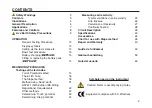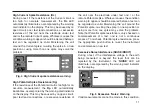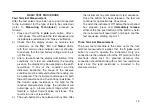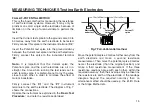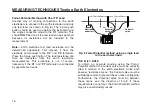
The
DET5/4R
and
DET5/4D
Megger Digital Earth
Testers are compact portable instruments designed to
measure earth electrode resistance and perform four
terminal continuity tests. They may also make earth
resistance tests which lead to the measurement of soil
resistivity. The
DET5/4R
has an internal rechargeable
battery, with an integral charger unit. The
DET5/4D
is
powered from six internal, replacement alkaline cells.
TEST METHOD
The instruments use the well known four-terminal
method of measurement in which the resistance of the
current circuit test leads does not affect the result.
In the
DET5/4R
and
DET5/4D
the resistance of the
Potential circuit test leads can also be ignored because
a buffer stage is incorporated to prevent the measuring
circuit from loading the earth resistance under test.
Operation of the instrument is extremely simple. Two
modes of operation are selected by means of two push
buttons; one for a three terminal test and one for a four
terminal test. All other functions of the instrument are
automatic.
A reversing d.c. test current, generated electronically
from a “floating” constant current source within the
instrument, is passed via the ‘C1‘ and ‘C2’ terminals
through the earth being tested. The potential
developed across the earth is compared with the
current and, after filtering and phase sensitive
detection the resistance is given directly on the digital
display.
Test frequency is 128 Hz and in the interests of safety
the maximum test voltage is limited to 50 V (peak)
between C1 and C2 terminals. Short circuit current is a
maximum of 10 mA.
INSTRUMENT DESIGN
The instruments are very robust and have tough cases
moulded in ABS plastic. Test leads are not supplied
with an instrument but form part of an earth testing field
accessory kit which is available as an option. This kit
also includes test spikes (electrodes) for making
temporary earth spikes.
Mounted on the front panel are two push-button
switches for testing using either 3 or 4 terminal
measurement. The instrument’s 3
1
⁄
2
digit liquid crystal
display shows the test result, warns of problems with
the test conditions and also indicates low battery
voltage. LEDs show high current circuit resistance, a
high Potential circuit resistance, (both usually caused
by a high test spike resistance) and a ‘Noisy’ earth
environment. As these factors can influence the
measurement being made, noise and current circuit
resistance are continuously monitored during a test,
while a check of the Potential circuit resistance is made
at the start of each test. The display shows all
measurements directly in ohms or kilohms with the
GENERAL DESCRIPTION
5
Summary of Contents for DET5/4D
Page 41: ...41...



